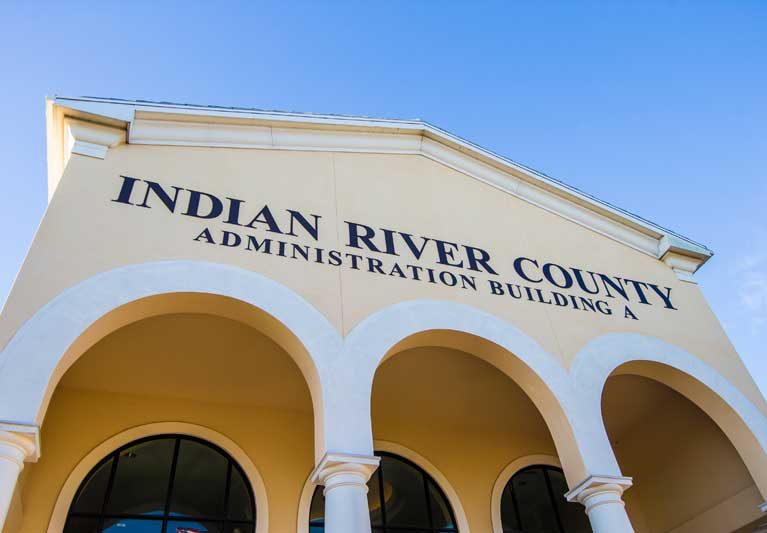
John’s Island Water Management officials will try to figure out a new way to supply more irrigation water to their community after losing a bid to sink a re-use water pipeline beneath the Indian River Lagoon.
A new approach is needed because the Indian River County Commission rejected the company’s request for a temporary construction easement across Hole in the Wall island for the proposed pipeline.
The commissioners voted 3-2 against the easement with Commissioners Joe Flescher and Peter O’Bryan leading the way and Commissioner Susan Adams going along at the last minute.
“With an alternative pipeline available, I don’t think the juice is worth the squeeze,” O’Bryan said.
There are safer ways to provide re-use water to John’s Island, like running another pipe on the Wabasso Causeway Bridge and south on State Road A-1-A.
It’s not clear that Indian River County owns Hole in the Wall island, so approving an easement could get the county into a legal dispute, O’Bryan and Flescher said.
The rejection seemingly dealt a mortal blow to the proposed lagoon pipeline because the Indian River Mosquito Control District, which also claims Hole in the Wall island, denied a similar request in February.
The district would consider filing a legal challenge if the county granted the easement, said Chairman Louis “Buck” Vocelle Jr., in an April 16 letter to the commissioners.
More than 200 people packed the commission chamber in the morning and about half were still there for the late afternoon vote.
Several environmental leaders argued it was too risky to install a pipeline carrying treated sewage water beneath the Indian River Lagoon when the estuary has already been badly damaged by pollution and there are safer ways to provide re-use water to John’s Island.
“Obviously, we’re not happy with it,” said John’s Island General Manager Michael Korpar said about the commission vote. “We’ll have to take it back to the John’s Island Water Management board and discuss what we do from this point on.”
Running a pipeline from the county’s Sea Oats Wastewater Treatment Plant on 77th Street to the Wabasso Causeway Bridge and south on A-1-A to John’s Island would not achieve the company’s goal of having a looped system and being first in line to get re-use water, Korpar said.
One of the reasons John’s Island officials proposed the $6 million re-use pipeline is to make sure they get one million gallons of water per day to irrigate the community’s landscaping and lawns, Korpar said.
John’s Island is at the end of Vero Beach’s re-use water pipeline and sometimes only gets about 100,000 gallons of water per day for irrigation, Korpar said.
Korpar and other John’s Island Water Management officials assured the commissioners they would use the most advanced technology and take every precaution to avoid polluting the Indian River Lagoon while constructing the pipeline.
“This project is safe and environmentally feasible and practical,” said Tom Cook, president of the John’s Island Water Management. “Every time something has arisen, we’ve hired some kind of a technical expert to address it.”
Commissioners Bob Solari and Tim Zorc said they wanted to grant the temporary construction easement because it’s environmentally better to rely on re-use water for irrigation than potable water.
The county wants to expand its re-use water program to dispose of the liquid byproduct of the sewage treatment process, Zorc said. Every 100 houses added to the sewer system produces 10,000 gallons of re-use water.
“Re-use is good, there are a lot of benefits from re-use,” Solari said. “Good potable water is in short supply. We draw down too much, too fast from our aquifers. We have to stop doing that. I’ve long thought the use of re-use water was the best way of doing it.”
“Is the risk worth the benefit of having this paid for by John’s Island and having a million gallons of reuse water a day,” Solari said. “I believe it is.”
But Flescher argued the murkiness of the ownership of the Hole in the Wall island would bog down the re-use pipeline project in a legal morass.
“Who owns this thing?” Flescher said. “It will go to the courts. This thing is going to be mired up and mucked up for six months, 18 months, we don’t know how long it’s going to be. It’ll be tied up.”
Adams initially said she wasn’t sure how she would vote but seemed swayed by the arguments granting the easement would trigger a lawsuit against the county.
After the vote, environmental activists lauded the commission for protecting the lagoon.
“The lagoon had a big win today,” said Leesa Souto, executive director of the Marine Resources Council. “For once, the natural resources are on the winning side. We all have a lot to lose from the lagoon’s continuing demise.”






